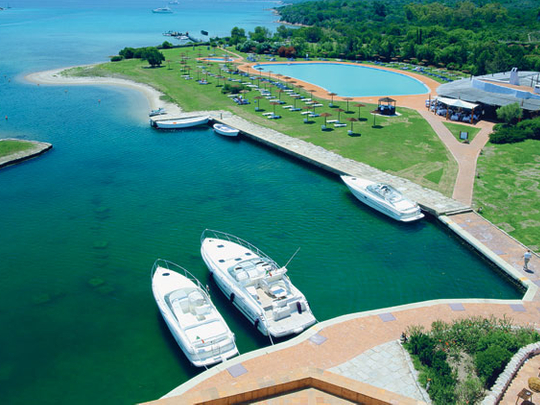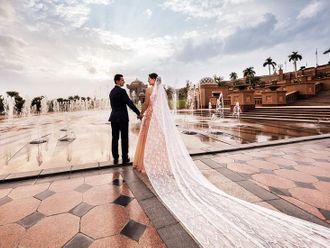
I had never been driven to tears by a weather forecast. But there in front of the TV screens at Cagliari airport, I felt that involuntary tremor of my lower lip, followed by a vague tightening in my throat and a glistening well that blurred my vision.
With steely determination I pulled myself together. I reminded myself that I had come to sample the culinary delights of Sardinia's famed cuisine, to immerse myself in its rich history, to explore its unique mountainous scrubland perfumed by wild thyme and rosemary. I was here to discover the "real" Sardinia.
Just 40 minutes' drive from Cagliari airport, beyond the flamingoes' nesting grounds of Sardinia's southwestern marshlands, lay our first port of call: Forte Village. This is a 25-hectare holiday wonderland. If only its gloriousness had been matched by the weather — leaden skies and an apocalyptic forecast of flash floods.
Soothing sights
Leaving our car at the reception, my friend Adam and I were taken on the journey to our hotel in a Noddy cart, crossing cobbled walkways flanked by gardenias, hibiscus and palm trees — and at every juncture a flamingo pond.
Greeting us at Le Dune, one of eight five-star hotels in the resort, was Giuseppe, the manager, who guided us past its glass-fronted Michelin restaurant and under the vine arches to our enormous suite. The room and the bathroom were beautifully decorated and, hidden by olive and palm trees, our terrace and private garden opened out to the seafront.
But I was still worried about the weather. Taking Giuseppe aside, I asked him about my chances of getting a tan.
"Worry not," he said. "At Forte Village we have a special micro-climate because of the mountains. It might rain only for a little while but then in no time is sunny again!"
The skies told a different story. Fearing that we might never get outside, I checked out the food facilities. There are more than 21 restaurants within a few paces of one another, ranging from those serving traditional fare, to steak houses, pizzerias and fine-dining venues.
Hotel in hinterland
Forte is a great place to holiday but I was restless. Armed with driving instructions in Italian and the fact that we knew the words for right and left, we travelled deep into Sardinia's hinterland, heading for Su Gologone, a country hotel surrounded by olive groves and vineyards in the Supramonte Mountains.
After a five-hour drive, I was amazed to find it was completely full. The hotel was established in the Sixties by the Palimodde family, who wanted to showcase the local "casalinga"-style cuisine, the type at the time found only in traditional Sardinian homes. Su Gologone's reputation grew and these days it attracts food connoisseurs in numbers.
By the gigantic open fireplace in the corner of the restaurant stood a petite elderly woman in traditional widow dress. Pasqua Palimodde governs every service in the restaurant. She learnt to cook from her grandmother, who in turn learnt from her grandmother, and employs only women in the kitchen. The same chefs have been preparing her family recipes for more than 40 years.
The appetite is aroused by the delicious antipasti, followed by culurgiones — finger-pinched pasta filled with mashed potato, pecorino cheese, garlic-parsley and mint. While eating the leek and fennel ravioli, I almost wept — again.
Like the food, the hotel decor is based on tradition. Pasqua's daughter, Giovanna, is the artist responsible for the tasteful weave of old and new and the development of the hotel's art centre where guests can learn embroidery and pottery from artists in residence.
Each room is dedicated to an individual Sardinian artist. Juniper branches hang from ceilings, bedspreads are woven with colourful embroidery, bold paintings, ornate carpets and tablecloths are all produced by local craftsmen.
Moony tunes
As night stars fell like a canopy of fairy lights above our heads, we were invited to the terrace to hear the traditional tenor singers from Oliena, the nearest town. Four men stood in a huddle facing one another. One man chanted a melody while the others followed it with guttural sounds. It was like a voyage to a prehistoric age, when people imitated the sounds of nature.
Next morning, after a refreshing dip in the hotel's natural spring pool, we headed off for our hike through the mountains. The giant granite peaks hide caves and valleys, where villagers over the centuries retreated to in times of threat.
From the highest peak, Punta Corrasi, we saw farmlands peter out into the wilderness of the macchia — an arid, jumbled landscape of myrtle, juniper, rosemary and sage. All along the way, we saw muflone — an ancient variety of wild sheep with horns — feasting on the grass.
With lush green moors, mountainous forests, farmland, lagoons, ocean and the macchia all within a swift panoramic view, Sardinia feels not so much a country as a compact continent.
Our journey on to The Costa Smeralda was simpler than our trip to Su Gologone: all we had to do was tuck our rented car behind a convoy of seven Ferrari convertibles heading towards the coast. They unknowingly guided us through the gates of one of the world's most expensive hotels — Cala di Volpe in Porto Cervo.
Built on the site of a fishing village, the 124-room Cala di Volpe was designed in 1963 by Frenchman Jacques Couelle and prides itself on its simplicity and rustic charm.
Michele Cantatore has been the face of Cala di Volpe for more than four decades and continues a tradition of employing local people. "They are the big reason why guests keep returning," he said. "They combine unfussy charm with hospitality."
Friendly vibes
We made for the restaurant, which is considered one of the best in the world. Our chef used a mobile stove to cook our meals to our tastes at our table, laughing and joking all the while. This personalised treatment ensured that we felt like old friends.
As the evening progressed, an elderly couple rose to dance by the piano. "We always dance when we come here," the lady said. I asked her how often she had returned. "Once a year has kept us going for 40," she said. "There is just nowhere like this on Earth. We can barely afford it with the recession but one has to keep on living, doesn't one?"
Costa Smeralda certainly suited her but if I am to return to these shores, I'll do as the Sardinians do and retreat to the hills, back to nature at Su Gologone — whatever the weather.
Cultural distinction
Sardinians are always keen to distinguish themselves from mainland Italians. This is apparent not only in the food but in every cultural detail. They even have their own ancient dialect — Sardo.
When D.H. Lawrence came to Sardinia with his wife Frieda in 1921, the thing that struck him most was the hospitality he received and the "salty" sincerity of the Sardinians, compared with "the macaroni slithery-slobbery mess of modern adorations" that he had observed elsewhere.
A warm welcome remains throughout the island. Perhaps it is because Sardinia joined the tourist route relatively recently, and cynicism hasn't set in.
Swept into shape
Sardinia is also known as The Unconquered Island. The Romans called the inland area Barbagio after the local tribes of barbarians as they could never conquer them.
The Forte resort is proud of the thalassotherapy treatment available in its thermae spa, where guests can exploit the beneficial effect of seawater in six high-saline density pools set in the tropical gardens.
Having bobbed about in the pools for an hour or so, I was ready to meet my "massotherapist", Andre. I told him about my previous back injury and he asked me to lie flat — while he dug out a huge broomstick.
I began to worry.
Having rolled the stick along my body, he pulled and tugged at my limbs and then — in what I thought was a slightly unconventional move — hung me upside-down by my feet until my skeleton shrieked. After a final roll of the broomstick, he said: "Lizzzzaaa, now you are aligned!"
Newly aligned, I was ready to see more of Sardinia.








